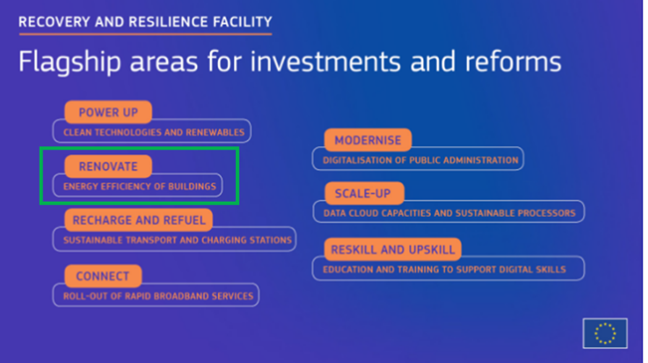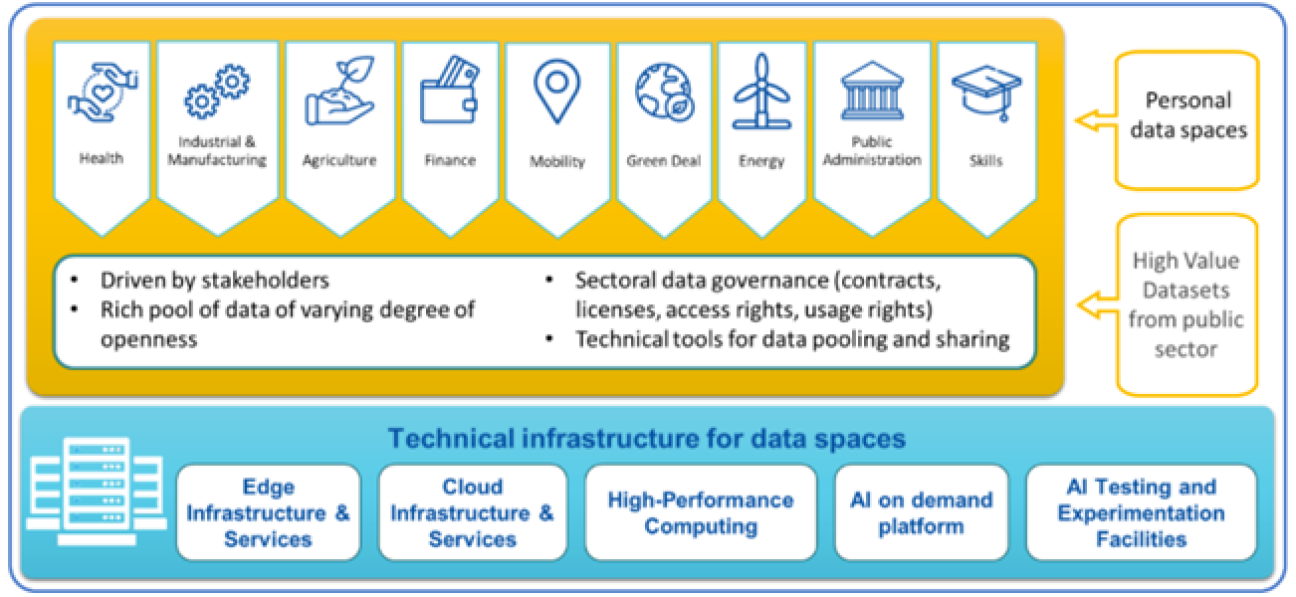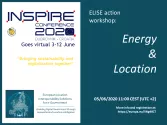
Background and scope
Use cases
Dissemination activities
Main achievements and lessons learned
Next steps
Background and scope
"ELISE Energy & Location Applications" aim to demonstrate how location data and technologies can support different stakeholders engaged in the energy efficiency policies' cycle.
More particularly, it shows how location data allows applying "scale-up" methodologies to assess the energy efficiency of buildings in a bottom-up approach, namely from local to urban to the district to regional to national level.
The case studies and described pilot applications started back in the EULF action focusing on different domains, such as transport, marine and energy efficiency.
The ELISE Energy & Location Applications coordinated by the European Commission's Joint Research Centre (JRC) has been carried out into two main phases:
Phase 1 was dedicated to a set of landscaping and preparatory activities, namely:
- an analysis of the three EU policy instruments in the field of energy efficiency (EPBD, EED, CoM), extracting from them the location-related business processes;
- an analysis of the state of the art research in Europe about geoICT applied to the energy efficiency sector;
- the identification of the relevant methodologies applied in the energy efficiency sector;
- an analysis on the availability of buildings related datasets in the INSPIRE Geoportal;
- the scoping of a series of use cases to be developed in phase 2, finalised in the frame of two international workshops with domain experts (the first in November 2015 and the second in September 2016), and also after consultation with the members of the ISA2 Working Group on Geospatial Solutions;
- The preparation of two non-monetary collaboration agreements among JRC and seven partners, with whom the use cases have been co-designed and co-executed.
The activities executed during phase 1 are fully described in the JRC Technical Report “EULF Energy Pilot - Final Report Phase 1”.
Use cases
The piloted case studies were the following. Click on the link on each of them to obtain detailed information.
Dissemination activities
Several dissemination activities have been carried out within the entire project life time:
- Workshop “Spatial data for modelling building stock energy needs”, Ispra (IT), 24-26 November 2015.
- Workshop “Methodologies for energy performance assessment based on location data”, Ispra (IT), 12-14 September 2016.
- Parallel session "INSPIREd Energy" at INSPIRE Conference 2016, Barcelona (ES), 30 September 2016.
- Internal seminar, Ispra (IT), 30 March 2017.
- Workshop "INSPIREd Energy" at INSPIRE Conference 2017, Kehl (DE), 5 September 2017.
- Seminar "Possible synergies between energy smart meters, SensorThings API and INSPIRE", Ispra (IT), 31 January 2018.
- “Energy & Location” thematic session at the INSPIRE Conference 2018, Antwerp (BE), 20 September 2018.
- SimStad workshop, Enschede (NL), 12 March 2020.
- “Energy & Location” thematic session at the INSPIRE Conference 2020, Virtual event, 5 June 2020 (presentations, video).
- Participatory Lab on ‘Location Intelligence4Cities and Regions’ at the European Week of Regions 2020, Virtual event, 14 October 2020 (JoinUp, session details, video).
- Workshop “ELISE enabling the interoperability of digital government from a location perspective” at the DigitALL Public Conference, Virtual event, 22 April 2021.
- Webinar "Digital platform for the smart management of infrastructures - the public lighting case", Virtual event, 20 May 2021.
- Webinar "3D City Models to Predict Energy Heat Demand", Virtual event, 17 June 2021.
- Webinar "Data-driven methodology for electricity characterisation of districts", Virtual event, 15 July 2021.
Main achievements and lessons learned
The case studies piloted have shown that location data can be a great ally to optimise energy efficiency policies. Main achievements and lessons learned for each of them are summarised in this section.
The energy policy instruments taken into consideration were the Energy Performance of Buildings Directive (EPBD), the Energy Efficiency Directive (EED) and Covenant of Mayors for Energy & Climate initiative (CoM). Although the two Directives are currently under review, the relevance of the developed use cases to the ELISE Energy & Location Applications main aim remains untouched.
Main achievement
- A methodology to predict energy heat demand at building level for an entire district or city, using as input data 3D buildings data in CityGML format and weather data, was developed, implemented and tested in 5 city areas of 4 different EU countries.
- A comparison between different levels of details of input data and the accuracy of output data was performed.
- Several mappings between CityGML and INSPIRE to improve the interoperability of input and output data of the energy simulations were made.
Lessons learned
- There is no linear dependency between the level of details of input data (3D building data) and the accuracy of output data (prediction of energy heat demand at building level).
- Predictions of energy heat demand cannot be validated with measures of energy consumption data because the former cannot consider the user behaviour, which influences the latter.
- It is not possible to define a unique labelling system for energy performance of buildings, valid across Europe. The solution is to refer to absolute values of energy demand expressed in KWh/m2/year.
- Despite an increased tendency to make 3D city models openly available, certain attributes required by the energy simulations, such as building age, are not open.
- Although SimStadt is open-source software, the pre-processing activities needed to prepare the input data to require certain skills
Main achievement
- A good practice of a national digital platform for smart management of public lighting in Italy was analysed.
- A survey to discover similar good practices in the other EU Member States was carried out.
- A solution to reuse the Italian good practices in other EU countries was identified.
Lessons learned
The survey to discover existing good practices for smart management of public lighting was not exhaustive.
Main achievement
- A methodology to characterise district areas (at postal code geographical scale) in terms of their energy behaviour, calculated from dynamic measurements of energy consumption open data accessible via API, was developed, implemented and tested in a Province in Spain.
- The methodology includes also a software tool that can be used to visualise a series of KPIs and to benchmark couples of analysed district areas.
Lessons learned
- A methodology to characterise district areas (at postal code geographical scale) in terms of their energy behaviour, calculated from dynamic measurements of energy consumption open data accessible via API, was developed, implemented and tested in a Province in Spain.
- The methodology also includes a software tool that can be used to visualise a series of KPIs and benchmark couples of analysed district areas.
Main achievement
- The role that geospatial data and technologies can play to support the design, implementation, and monitoring of a regional energy strategy, based on a real case of Castilla y Leon, Spain, was investigated.
- The availability of open geospatial data, useful for a regional energy strategy cycle, was analysed.
Lessons learned
The availability of relevant harmonised and interoperable geospatial data at the local level and documented workflows for data processing would represent strong support for the policy cycle of a regional energy strategy.
Main achievement
- A data model (EPC4EU) to harmonise across Europe datasets of Energy Performance of Buildings Certificates (EPCs) was developed.
- The data model was applied to harmonise EPC datasets in Italy and Spain.
- A prototype web application to make the data usable by non-experts was developed.
Lessons learned
The full exploitation of the EPC4EU data model is hindered by the inhomogeneous terminology used by the national EPC schemes. Another obstacle is represented by the possible lack of georeferenced information in the EPCs (observed in Spain), which requires additional data processing steps.
Main achievement
A data model for harmonising the data contained in the Sustainable Energy Action Plans produced by the Local Authorities signatory of the Covenant of Mayors. It can better support the coordination of energy policies at the provincial/regional level was developed, implemented and tested with 100+ SECAP data of municipalities of the Autonomous Province of Trento (IT).
Lessons learned
The re-use of the methodology in other geographical contexts is currently limited by the access restrictions existing on the SECAP data from the CoM database (only the pdf version of the SECAPs is open).
Next steps
Besides a series of possible specific next steps directly linked to the lessons learned above reported, two main more general directions could be follow up:
- plan and execute more sandboxing activities to bring the prototype methodologies and tools developed in the use cases to a more mature level of solutions readily re-usable by all the beneficiaries already identified,
- design and execute additional use cases focusing on European energy policies concerning those analysed in the reported use cases, e.g. Renewable Energy Directive.
More generally , ELISE Energy & Location Applications can contribute to the European Green Deal, the Recovery and Resilience Facility and the Common European energy data space.
The energy efficiency of buildings is one of the pillars of the European Green Deal and, particularly, of the Renovation Wave strategy, as schematically shown in the figure below.

Moreover, the energy efficiency of buildings is also one of the seven flagship areas for investments and reforms foreseen by the Recovery and Resilience Facility.

The above-mentioned policy instruments can strongly benefit from the availability of data at the building level, which allows characterising, in a harmonised and interoperable way across Europe, the building stock conditions at the local, regional and national level.
Such benefits were already partially highlighted in the JRC Science for Policy Report “Building energy renovation for decarbonisation and Covid-19 recovery”.
However, more detailed examples of how location data at the building level can support the energy efficiency policy cycle are provided in the Joint Research Centre Technical Reports, illustrating in detail the activities executed in the ELISE Energy & Location Applications use cases described in detail in previous sections.
Energy is one of the nine sectors for which a common European data space will be established, as stated in the Communication “A European strategy for data“.

In particular, the Commission:
- will support the establishment of a Common European energy data space “to promote a stronger availability and cross-sector sharing of data, in a customer-centric, secure and trustworthy manner, as this would facilitate innovative solutions and support the decarbonisation of the energy system.”
- Will “consider actions for improving the interoperability in smart buildings and products, with a view to improve their energy efficiency, optimise local consumption and broaden the integration of renewable energy sources.”
Moreover, in the Appendix of the above mentioned Communication, it is stated that:
“In the energy sector, several Directives establish customer access to and portability of their meter and energy consumption data on a transparent, non-discriminatory basis and in compliance with data protection law. The specific governance frameworks are to be defined at the national level. Legislation also introduced data-sharing obligations for electricity network operators. Regarding cybersecurity, work is ongoing to address energy-specific challenges, notably: real-time requirements, cascading effects and the mix of legacy technologies with smart/state-of-the-art technology.
The availability and cross-sector sharing of data, in a secure and trustworthy manner can facilitate innovative solutions and support the decarbonisation of the energy system.”
The definition of the mechanisms for the set-up and governance of the common European energy data space, primarily the definition of interoperability requirements, is still ongoing.
However, within the context above described, the “Scale-up methodologies” use case represents an example of an ecosystem of open data, technologies and actors well-fitting for the common European energy data space concept. A bottom-up electricity characterisation methodology of the building stock at the local level was developed, implemented and validated, based on the statistical analysis of aggregated energy consumption data, weather data, cadastre and socioeconomic information



